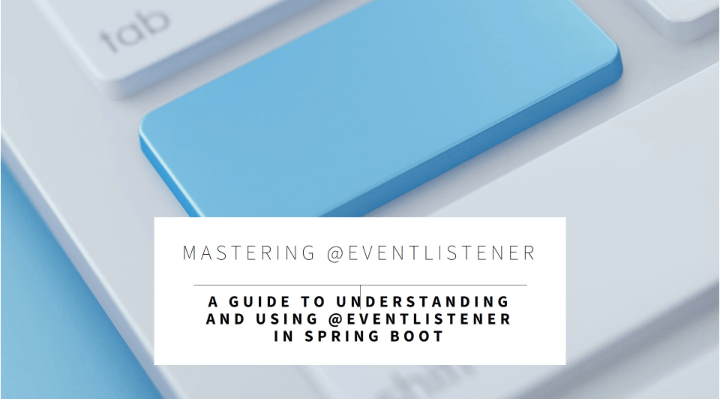
@EventListener 注解是 Spring 框架中用于处理应用程序事件的工具。它可以应用于任何 Spring 管理的组件中的方法,以监听特定的应用程序事件,包括预定义的事件和自定义事件。
它是 Spring 事件驱动编程模型的一部分,旨在促进组件之间的松耦合。你可以利用 @EventListener 来响应应用程序中的某些操作或变化,例如用户注册、订单提交或应用程序启动。
@EventListener 的关键特性
-
事件驱动架构:促进组件之间的解耦通信。
-
处理自定义和内置事件:适用于预定义的 Spring 事件(如
ContextRefreshedEvent、ApplicationReadyEvent等)或用户定义的事件。 -
异步处理:可以与
@Async结合使用,实现非阻塞的事件处理。 -
条件监听:使用
condition属性和 SpEL(Spring 表达式语言)来基于条件监听事件。
@EventListener 的示例用例
1. 自定义事件处理
当用户注册时,触发事件以发送欢迎邮件。
// Custom Event Class
public class UserRegisteredEvent {
private final String username;
public UserRegisteredEvent(String username) {
this.username = username;
}
public String getUsername() {
return username;
}
}
// Event Publisher
@Component
public class UserService {
@Autowired
private ApplicationEventPublisher eventPublisher;
public void registerUser(String username) {
// Perform registration logic here...
System.out.println("User registered: " + username);
// Publish event
eventPublisher.publishEvent(new UserRegisteredEvent(username));
}
}
// Event Listener
@Component
public class WelcomeEmailService {
@EventListener
public void handleUserRegistered(UserRegisteredEvent event) {
System.out.println("Sending welcome email to: " + event.getUsername());
}
}
// Controller to trigger the event
@RestController
public class UserController {
@Autowired
private UserService userService;
@PostMapping("/register")
public String registerUser(@RequestBody String username) {
userService.registerUser(username);
return "User Registered!";
}
}2. 内置事件处理
在应用程序启动时自动执行某些操作,例如初始化资源。
@Component
public class StartupListener {
@EventListener(ApplicationReadyEvent.class)
public void onApplicationReady() {
System.out.println("Application is ready! Performing startup tasks...");
}
}3. 异步事件处理
如果事件处理过程耗时,可以使用 @Async 实现非阻塞执行。
@Configuration
@EnableAsync
public class AsyncConfig {
@Bean
public Executor taskExecutor() {
return new SimpleAsyncTaskExecutor();
}
}
@Component
public class NotificationService {
@Async
@EventListener
public void sendNotification(UserRegisteredEvent event) {
System.out.println("Processing notification for user: " + event.getUsername());
// Simulate delay
try {
Thread.sleep(3000);
} catch (InterruptedException e) {
Thread.currentThread().interrupt();
}
System.out.println("Notification sent for: " + event.getUsername());
}
}4. 条件监听
使用 condition 属性基于特定条件处理事件。
@Component
public class AdminNotificationService {
@EventListener(condition = "#event.username == 'admin'")
public void notifyAdmin(UserRegisteredEvent event) {
System.out.println("Special handling for admin user: " + event.getUsername());
}
}更复杂的条件示例:
@EventListener(condition = "#event.user=='arvind'") // Equality
@EventListener(condition = "#event.user!='arvind'") // Inequality
@EventListener(condition = "#event.age > 18") // Greater than
@EventListener(condition = "#event.age >= 18") // Greater than or equal
@EventListener(condition = "#event.age < 18") // Less than
@EventListener(condition = "#event.age <= 18") // Less than or equal
@EventListener(condition = "#event.user matches 'ar.*'") // Regex match
@EventListener(condition = "#event.role.equals('ADMIN')") // Object equality
// Logical operators
@EventListener(condition = "#event.age > 18 and #event.user=='arvind'") // AND
@EventListener(condition = "#event.age > 18 or #event.user=='arvind'") // OR
@EventListener(condition = "!#event.isDeleted") // NOT
// Collection operations
@EventListener(condition = "#event.roles.contains('ADMIN')") // Contains
@EventListener(condition = "#event.tags.size() > 0") // Size check
// Null checks
@EventListener(condition = "#event.user != null") // Not null
@EventListener(condition = "#event.user?.length() > 5") // Safe navigation
@EventListener(condition = "#event instanceof T(com.example.AdminEvent)") // Type check
@EventListener(condition = "#event.timestamp > T(java.time.Instant).now().minusSeconds(3600)") // Time comparison使用 @EventListener 的好处
-
解耦:事件发布者和监听者不相互依赖,促进了更好的模块化。
-
灵活性:监听者可以处理多种类型的事件,减少了重复代码。
-
可扩展性:通过异步事件处理,应用程序可以处理多个事件而不会阻塞。
总结
@EventListener 是 Spring 框架中一个强大的工具,用于实现事件驱动的编程模型。通过使用它,你可以轻松地处理自定义和内置事件,实现异步处理,并根据条件监听事件。这种机制不仅提高了代码的灵活性和可维护性,还增强了应用程序的可扩展性。






没有回复内容